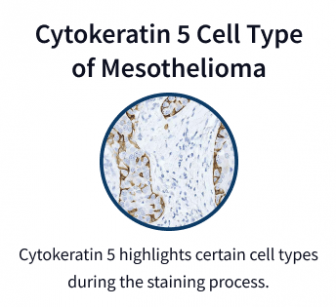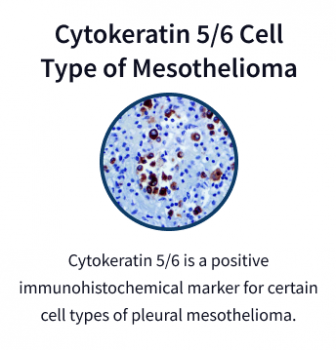Cytokeratin 5 & 5/6 and Mesothelioma
Cytokeratin 5 and 5/6 are proteins that help pathologists tell the difference between mesothelioma and other forms of cancer. Cytokeratin 5/6 is a positive immunohistochemical marker for certain cell types of pleural mesothelioma. It is not as useful for diagnosing peritoneal mesothelioma.

Written byKaren Selby, RNEdited ByWalter PachecoMedically Reviewed ByDr. Jeffrey Velotta
Asbestos.com is the nation’smost trustedmesothelioma resource
The Mesothelioma Center at Asbestos.com has provided patients and their loved ones the most updated and reliable information on mesothelioma and asbestos exposure since 2006.
Our team of Patient Advocates includes a medical doctor, a registered nurse, health services administrators, veterans, VA-accredited Claims Agents, an oncology patient navigator and hospice care expert. Their combined expertise means we help any mesothelioma patient or loved one through every step of their cancer journey.
More than 30 contributors, including mesothelioma doctors, survivors, health care professionals and other experts, have peer-reviewed our website and written unique research-driven articles to ensure you get the highest-quality medical and health information.
About The Mesothelioma Center at Asbestos.com
- Assisting mesothelioma patients and their loved ones since 2006.
- Helps more than 50% of mesothelioma patients diagnosed annually in the U.S.
- A+ rating from the Better Business Bureau.
- 5-star reviewed mesothelioma and support organization.
Testimonials
My family has only the highest compliment for the assistance and support that we received from The Mesothelioma Center. This is a staff of compassionate and knowledgeable individuals who respect what your family is experiencing and who go the extra mile to make an unfortunate diagnosis less stressful. Information and assistance were provided by The Mesothelioma Center at no cost to our family.LashawnMesothelioma patient’s daughter
How to Cite Asbestos.com’s Article
APA
Selby, K. (2023, June 12).Cytokeratin 5 & 5/6 and Mesothelioma.Asbestos.com. Retrieved September 21, 2023, from //www.magnakarsa.com/mesothelioma/diagnosis/immunohistochemical-markers/cytokeratin/
MLA
Selby, Karen. "Cytokeratin 5 & 5/6 and Mesothelioma."Asbestos.com, 2023年6月12日,//www.magnakarsa.com/mesothelioma/diagnosis/immunohistochemical-markers/cytokeratin/.
Chicago
Selby, Karen. "Cytokeratin 5 & 5/6 and Mesothelioma." Asbestos.com. Last modified June 12, 2023. //www.magnakarsa.com/mesothelioma/diagnosis/immunohistochemical-markers/cytokeratin/.
What is Cytokeratin 5 & 5/6?
Cytokeratins are keratin proteins found in the epithelial tissue. This tissue lines the outer surfaces of organs and blood vessels. They provideepithelial cellswith structural support.
The different types of cytokeratins get numbered based on their location in the body.

Cytokeratin 5 lives in the cells on the outermost layer of skin in humans and animals. The KRT5 gene encodes it and pairs with the type I keratin K14.
Cytokeratin 5 has become an importantbiomarker为不同类型的癌症。这包括mesothelioma, breast cancer and lung cancer. CK5 has characteristics that help differentiate squamous carcinomas from adenocarcinomas.
Pathologists use cytokeratin 5 to distinguish mesothelioma from adenocarcinoma. It is the most common type of lung cancer. They do this by staining tissue samples with cytokeratin 5/6, an antibody that detects cytokeratins 5 and 6.
Cytokeratin 5/6 cannot identify cancerous mesothelioma on its own. Pathologists use severalimmunohistochemical markerswhen diagnosing the cancer.
Cytokeratin 5 and 5/6 in Diagnosing Mesothelioma
Cytokeratin 5/6 is a positive marker formalignant pleural mesothelioma, found in more than three-fourths of cases. It is also found in certain types of lung cancers and breast cancers. Pathologists use cytokeratin 5/6 to stain cancer tissue samples.

Pleural mesothelioma is often misdiagnosed as lung cancer. Especially iftumors have spreadbeyond the point of origin to other parts of the body.
Using immunohistochemical markers such as cytokeratin 5/6, pathologists can differentiate tumor cells. With rare exceptions, epithelial mesothelioma is the only tumor with glandular morphologic features that shows cytokeratin 5/6.
Cytokeratin 5/6 immunoreactivity is rarely seen in adenocarcinomas of the lung. If a tumor sample shows strong expression of cytokeratin 5/6, it gives pathologists a hint the tumor ismalignant mesotheliomarather than a metastatic adenocarcinoma.
But, this marker is not effective for all cell types of mesothelioma. Cytokeratin 5/6 staining is usually weak or negative forsarcomatoid mesothelioma, the least common and hardest-to-treat cell type of the asbestos-related cancer.
It is also not effective in telling between pleural mesothelioma and squamous cell carcinomas. About 25% to 30% of all lung cancers are squamous cell carcinomas.
Mesothelioma Research Studies Involving Cytokeratin 5/6
Several studies have evaluated cytokeratin 5/6 as a diagnostic marker for mesothelioma.
Cytokeratin and p63 are effective in differentiating cancers of unknown primary sites. A 2001 study in theAmerican Journal of Clinical Pathologyshowed this fact. The study included 14 malignant mesotheliomas.
Cytokeratin 5/6 and calretinin are markers for mesothelioma in effusion samples. Effusion, or the buildup of excess fluid, is a common symptom of pleural and peritoneal mesothelioma.
Cytokeratin 5/6 staining was present in 33 of 34 mesothelioma cases in the study. While only six of 67 adenocarcinomas tested positive for the protein.
The study noted cytokeratin 5/6 staining may be less useful forperitoneal effusionspecimens. Metastatic adenocarcinomas are more likely to express the marker in the abdomen.
A 2002 study in Modern Pathology raised caution over using cytokeratin 5/6 to differentiate mesothelioma from metastatic adenocarcinoma. The study showed many types of nonpulmonary adenocarcinomas may be positive for cytokeratin 5/6. Pathologists must rely on other markers as well.









